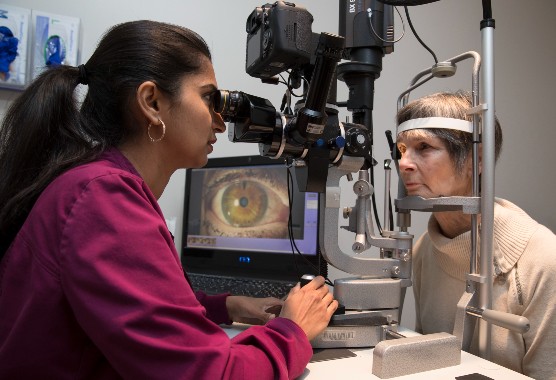Eye and Vision-Related Cancer
Our eye cancer team offers comprehensive treatment options designed to save your vision and improve your quality of life.
Medically reviewed by Susanna Park, M.D. on Aug. 31, 2023.

Partnering With You for Eye Cancer Care
Eye cancers include those covering the surface of the eye and those that happen internally. Our eye cancer specialists work with you to identify, diagnose and treat eye and vision-related cancers. Research efforts are also underway at UC Davis to study the effects of other cancers on the eyes.
What Is Eye Cancer?
Eye (ocular) cancer happens when cancer cells in your eye grow and multiply, forming tumors. These primary eye cancers originate on your eye’s surface or inside of it.
Tumors on the surface tend to grow slowly, and we often can treat them with surgery. But tumors inside the eye tend to grow and spread faster. They need radiation and other treatments more often than surface tumors.
Sometimes, cancers that start in other areas of the body spread to the eye. These types of eye cancer are called secondary eye cancers.
There are several types of eye cancer. The most common are:
- Uveal melanoma (intraocular or ocular melanoma): Uveal melanoma forms in the eye’s uvea. The uvea is the middle layer of the eye wall and includes the iris, the part of your eye responsible for eye color. Although uveal melanomas are rare, they are the most common primary eye cancer found in adults. The melanoma often grows from a nevus (or “mole”) and can be fatal if it grows and spreads to other parts of the body. Physicians treat uveal melanoma with eye radiation or surgery to minimize the risk of growth and metastasis (spread) of the cancer.
- Retinoblastoma: Retinoblastoma is a rare cancer that starts in the eye’s retina. The retina forms the inner layer of the back portion of the eye. It is the part of your eye responsible for sight. Retinoblastomas are the most common primary eye cancer in children. With early care, physicians can successfully treat these eye cancers. Treatments may involve eye laser or surgery and chemotherapy, depending on severity of the cancer.
It’s also possible to develop tumors in other parts of the eye:
- Orbital cancers happen when cancer grows in the tissues around the eye, including muscles and nerves.
- Adnexal cancers grow in structures that support eye health, such as eyelids and tear glands.
Eye Cancer Symptoms
In some cases, there are no symptoms of eye cancer. But the cancer can be diagnosed during a routine eye exam.
Common Symptoms
Common eye cancer symptoms include:
- Changes in your eye’s appearance if you have cancer on the surface or around the eye
- Changes in your pupil’s shape
- Changes in how your eyeball sits or moves within the eye socket
- Dark spot on your iris or on the white part of your eye
- Vision changes, including sudden vision loss, blurred vision and new floaters or flashes
Eye Cancer Causes and Risk Factors
Rarely, inherited genes cause cancers in the eye. In our Ocular Genomics Clinic, we provide genetic testing to help you better understand your personal risk. Read more about genomic medicine at UC Davis Health. Researchers are currently investigating other potential causes of ocular cancer.
Some potential risk factors of eye cancer include:
Age
Eye cancers are more common in people between the ages of 50 and 80. Retinoblastomas most often affect children under 6.
Ethnicity
White people are more likely to develop certain cancers of the eye, such as uveal melanoma, than people of other ethnicities.
Having certain types of moles
Certain kinds of eye and skin moles and freckles may increase your risk of developing eye melanoma.
Eye color
People with blue and green eyes have a higher risk of developing certain eye cancers.
Diagnosing Eye Cancer
Ophthalmologists (eye specialists) diagnose eye cancer by examining your eyes and getting your medical history. Your ophthalmologist uses standard eye care tools like magnifying lenses and special lights during the exam.
You may have your eyes dilated during your visit. Eye dilation uses special drops to widen your pupils (the black circle in the center of your iris, or eye color). It helps your physician see the back of your eye better.
You may also need more eye imaging tests, such as:
- Ultrasound: An ultrasound exam uses sound waves to create images of your eye.
- CT scan: CT scans create detailed eye images by combining X-rays taken at different angles.
- Fluorescein angiography: Fluorescein angiography uses a special dye to highlight the circulation of the retina, choroid, and the tumor.
- MRI: MRI scans use powerful magnets, radio waves, and a computer to create precise 3D images of the eyes.
Eye Cancer Treatments at UC Davis Health
Eye surgeons in UC Davis Health’s eye cancer program can remove most tumors from your eye’s surface without removing your eye. Treatment of tumors inside the eye varies depending on the cancer. The treatment may include eye radiation, eye surgery, and chemotherapy.
The best eye cancer care involves collaboration among many kinds of eye specialists, including:
- Eye pathologists (lab specialists who focus on eye tissues and cells)
- Ophthalmologists
- Reconstructive eye surgeons
- Retinal surgeons
At UC Davis Comprehensive Cancer Center, your eye cancer team includes these highly trained eye specialists, along with experts in:
- Cancer
- Diagnostic radiology
- Hereditary Cancer Program
- Hematology and medical oncology
- Radiation oncology
- Pathology and laboratory medicine
These experts work together to create a personalized treatment plan that includes preserving and improving your quality of life. Read more about the advanced care we deliver at UC Davis Eye Center.
Eye Cancer Surgery
Our eye surgeons offer the full range of surgical options to treat eye cancer. The type of surgery you need depends on several factors, including the location and size of the eye tumor, the type of eye cancer and your overall health.
Our goal is to preserve your eye and vision. But surgery to remove your eye may be needed in advanced cases. If we remove your eye, we make you a prosthesis to help you look as natural as possible.
Radiation Therapy
At UC Davis Comprehensive Cancer Center, we offer the most advanced radiation therapies available, including proton beam therapy and stereotactic radiation therapy. These advanced, high-precision treatments decrease your risk for damage to nearby healthy tissues.
Laser Therapy
We can treat smaller eye tumors using laser therapy. During laser therapy, we use heat from light energy to destroy the tumor or the blood vessels nourishing it. Our ophthalmologists can treat you with laser therapy in their office or an operating room.
Cryopexy (Cryotherapy)
Cryopexy is a procedure that uses extreme cold to treat small eye tumors. During cryopexy, ophthalmologists use a special probe that repeatedly freezes and thaws the tumor, which kills it. Our ophthalmologists can perform cryopexy in their office or an operating room.
"Ocular melanoma: an overview of the current status," NIH National Library of Medicine, https://www.ncbi.nlm.nih.gov/pmc/articles/PMC3693189/
Who does uveal melanoma affect?
5 in 1MPeople each year
How many children does retinoblastoma affect?
1 in 18KLive births
Sources:
Ophthalmology: Uveal Melanoma: Trends in Incidence, Treatment, and Survival
National Institutes of Health: Retinoblastoma: A Major Review
Request an Appointment
Our cancer specialists provide thorough evaluations and personalized treatment plans. Learn more about how to make an appointment at UC Davis Comprehensive Cancer Center.
Patients
New Patient Referral Office
916-734-5959
UC Davis Health Referring Physicians
For providers in UC Davis Medical Group or our Cancer Care Network
Physician Referral Center
916-734-5959
External Referring Physicians
For providers who are external clinicians
Referral Office
800-770-9261

Ranked among the nation’s best hospitals
A U.S. News & World Report best hospital in cardiology, heart & vascular surgery, diabetes & endocrinology, ENT, geriatrics, neurology & neurosurgery, and pulmonology & lung surgery.

Ranked among the nation’s best children’s hospitals
U.S. News & World Report ranked UC Davis Children’s Hospital among the best in pediatric nephrology, orthopedics*, and pulmonology & lung surgery. (*Together with Shriners Children’s Northern California)

Ranked Sacramento’s #1 hospital
Ranked Sacramento’s #1 hospital by U.S. News, and high-performing in aortic valve surgery, back surgery (spinal fusion), COPD, colon cancer surgery, diabetes, gynecological cancer surgery, heart arrhythmia, heart failure, kidney failure, leukemia, lymphoma & myeloma, lung cancer surgery, pacemaker implantation, pneumonia, prostate cancer surgery, stroke, TAVR, cancer, orthopedics, gastroenterology & GI surgery, and urology.

The nation’s highest nursing honor
UC Davis Medical Center has received Magnet® recognition, the nation’s highest honor for nursing excellence.

World-class cancer care
One of ~59 U.S. cancer centers designated “comprehensive” by the National Cancer Institute.

A leader in health care equality
For the 13th consecutive year, UC Davis Medical Center has been recognized as an LGBTQ+ Healthcare Equality Leader by the educational arm of America’s largest civil rights organization.

